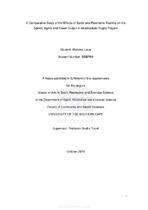| dc.description.abstract | Rugby games are characterised by intense bursts of speed mainly executed by backline players at either maximum or sub-maximum velocities over distances of up to 70 meters. Other key features of the game include rapid directional changes, displays of power and other dynamic activities such as lifting and jumping in the lineouts, tackling, pushing in scrums and contesting for the ball. These bouts of intense physical activity constitute a major part of the game, which take place over a period of 80 minutes and in some instances even longer. These powerful spells of play are interspersed by brief periods of rest mainly due to stoppages called by the referees when rules are infringed, when the ball is out of play, or when players incur injuries. These breaks can also be due to play being reviewed by match officials.
It is quite evident from the aforementioned that speed, agility and power are essential performance components for any rugby player and, with an increased focus on mobility and speed in the modern game, the importance of these components has increased in significance. Coaches are consequently continuously searching for training and coaching techniques that will maximally develop these qualities to give their teams an advantage over their opponents. Both line sprinting and plyometric training have proven to have beneficial effects on speed and power output. However, there is a dearth of research information on which one of the two approaches is the most beneficial. The purpose of this study, therefore, was to determine which training regime, line sprinting or plyometric training, brings about the biggest improvement in the
speed, lower body power output, agility and speed of intermediate rugby players.
This study employed a quasi-experimental research design, as it did not include a control group. Participants included 22 rugby players participating at club level, aged 18-25 years, with training sessions on at least three days of the week and a league or friendly match once a week. The players were randomly placed in either the line sprinting group or the plyometric training group (11 players per group). Participants were informed of the possible experimental risks of the study. All participants were required to complete a health questionnaire to ensure no chronic illnesses or major signs and symptoms suggestive of coronary artery or pulmonary disease were present in anyone taking part in the study. Participants took part in either sprint or plyometric training twice a day, with at least one day of rest in between training days. Participants were assessed on their speed, speed endurance, agility and power components pre -and post the eight-week intervention period. For the speed tests done before and after the intervention programme, participants performed maximal sprints over 40- and 80-metre distances. For agility, the T-test was used, and for power, the standing long jump. The research received ethics clearance from the University of the Western Cape’s Biomedical Research Ethics Committee (Ethics Reference Number: BM17/1/17).
After the eight-week intervention programme, the line sprinting group improved significantly in their performances for three of the four performance measures. The only measure that did not improve significantly was the 80m sprint. The plyometric group on the other hand showed improvements in two categories only - agility and the standing long jump – while no significant improvements were found in any of the sprint distances.
In conclusion, the findings demonstrated that both line sprinting and plyometric training regimes are effective in improving agility and leg power and that line sprinting performed over 10, 20, 40 and 100 metres is an effective training protocol to improve 40m sprint time. Neither the line sprinting nor the plyometric training resulted in significant improvements over the 80-m distance. A comparison of the effect sizes of the two training methods revealed that except for the improvement in agility of the plyometric training group, the speed, power and sprint endurance training benefits of these two training methods do not differ. | en_US |

